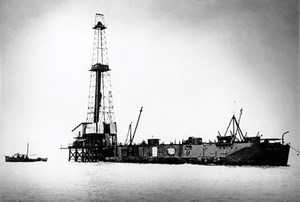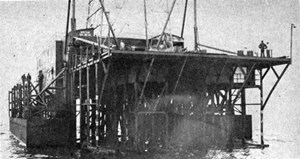The Gulf Coast Continental Shelf: The birthplace of many early offshore developments

While many aspects of the oil and gas industry—including exploration and advances in technology—slowed to a crawl after WWII, one area of the industry managed to make monumental strides, despite a suppressed commercial environment.
Drilling over water, close to land, had been ongoing for more than 40 years by the time the first offshore well was drilled in the Gulf of Mexico. In 1938, Creole oil field—with a 30,000-ft2 platform, about a mile offshore Louisiana, in 14 ft of water—became the first producing property in the Gulf. Then, in 1941, the first oil discovery off the Texas coast was made offshore Jefferson County.
Naturally, this success resulted in more offshore leases, and drilling projects began moving further and further out to sea. As the water depth increased, operators were forced to find alternate ways of supporting exploratory wells in conditions they had never before faced. Fixed platforms were no longer viable, even with tender-assist.
In 1947, Kerr-McGee Oil Industries partnered with Phillips Petroleum and Stanolind Oil & Gas Company to secure leases for exploratory wells in the Gulf of Mexico. With the intention of uncovering a potential source of salt-dome oil, they hired Brown & Root to build an experimental, freestanding, drilling platform, approximately 10 mi off the Louisiana coast. The offshore rig, named Kermac No. 16, was the only one of its kind, and it drilled the first successful oil well, out of sight of land. On Sept. 10, 1947, the well was spudded, although activity then ceased, due to a hurricane. Drilling resumed soon thereafter, and on Nov. 14, the well came in, producing up to 40 bbl/hr, initially.

Then, in 1948, John T. Hayward, a marine engineer working with a group of independent drilling companies, designed a submersible barge, which incorporated columns on the barge deck to support a drilling deck high enough to prevent any interference from intensified weather conditions. That top deck was capable of supporting an entire drilling rig. Once the barge was lowered, the force of the ocean waves connected only with the columns, keeping the drilling platform raised to a safe distance above the water.
The pontoons positioned on either side of the barge also made Hayward’s design uniquely worthwhile. The pontoons were intended to provide stability and displacement control, while the hull was sunk for drilling, as well as when it was raised afterward. The rig was designed to operate safely in water depths up to 20 ft.
Despite his clients’ reservations regarding the rig’s ability to remain upright during ballasting and deballasting, Hayward convinced them to build it. The Breton Rig 20 was completed in 1949, and was put into operation that same year. Without incident, it drilled a number of wells in the Gulf of Mexico. Each well was drilled 10 to 15 mi apart, and needed only a day or so for transport between drilling sites. In August 1949, World Oil devoted a six-page feature to the latest offshore drilling development.
With so much progression in the U.S. offshore industry, jurisdiction over the country’s offshore territory became a concern, and what became known as the “Tidelands Controversy” was in full swing by 1947. After WWII, the federal government made attempts to regulate offshore drilling activity, in an effort to conserve the nation’s resources, and prevent over-development. Many coastal states, however, claimed sole jurisdiction of their own offshore regions.
Despite complications and the many lawsuits that resulted from the controversy, World Oil reported that offshore drilling of wells on the Continental Shelf along the Gulf Coast had reached an all-time high by July 1948. World Oil reported: “Eight large companies are climaxing months of preliminary work with extensive exploratory activities on the Gulf Coast Continental Shelf, which some authorities estimate will yield upwards of 6 billion barrels of crude. Extending about 30 miles seaward and dotted with salt domes comparable to those in the rich fields of Texas and Louisiana, this area may contain some of the world’s most prolific oil deposits.” ![]()


